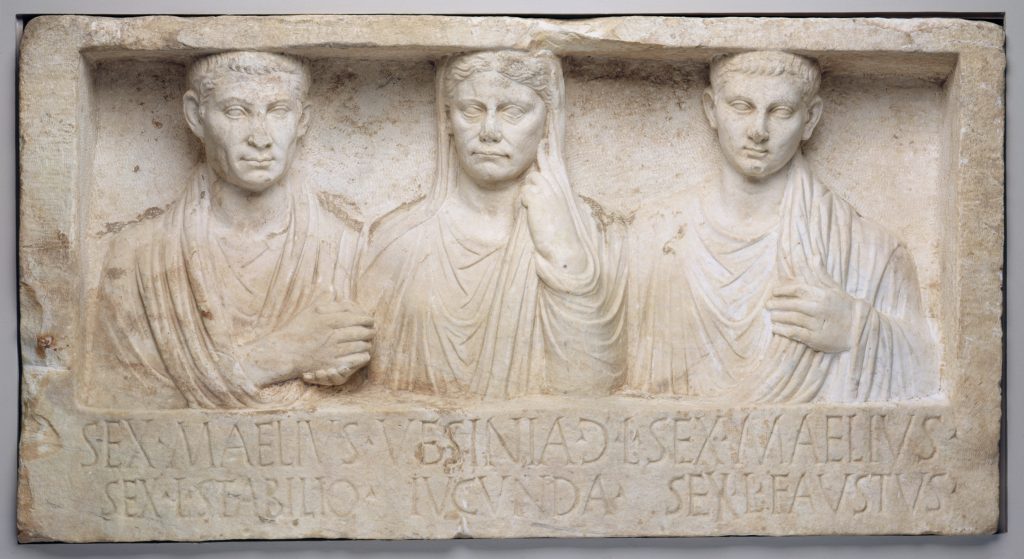Funerary Monument for Sextus Maelius Stabilio, Vesinia Iucunda, and Sextus Maelius Faustus (work of art)
Artwork Info
Key Ideas
- This funerary (burial-related) monument was originally part of a stone tomb that stood along a major road outside Rome. It is a relief carving, or a sculpture with carved figures that stick out from the background while still being attached to it.
- It depicts three human figures: a man, a woman, and a young man or boy. The letter L at the bottom of the work identifies these figures as freed people; this letter stands for libertus, meaning “freedman” and liberta, meaning “freedwoman.”
- The man on the left and the woman are depicted shaking hands, which represents their marriage. The young man on the right is most likely the couple’s son, born to them while they were still enslaved.
- The father and son each wear a toga, a type of garment that was only permitted to be worn by Roman citizens. The mother, depicted wearing a bridal veil, holds her left hand to her face. This gesture suggests her compliance with traditional Roman values.
Learn More
This marble relief was carved to fit into the front of a stone tomb that stood along a major road outside Rome. The Latin inscription, or writing carved into the stone, identifies the three figures as Sextus Maelius Stabilio, Vesinia Iucunda, and Sextus Maelius Faustus. Slavery was common in ancient Roman society. When an enslaved person was released from slavery through a process called manumission, they took on the family name of the person who had enslaved them. The father (Stabilio) and the son (Faustus) depicted on this monument have the name of their former enslaver, Sextus Maelius. The mother (Iucunda) has the name Vesinia from her former enslaver. The letter L in the inscription stands for libertus, meaning “freedman,” and liberta, meaning “freedwoman.” Freed individuals did not have all the privileges of citizenship, but they were still considered citizens and had the right to vote, trade, and obtain local religious leadership roles.
The symbols of marriage in this relief reflect the importance of family during the reign of Augustus (27 BCE to 14 CE). The handshake shared by the man and the woman identifies them as husband and wife. Stabilio wears a toga, a garment that could only be worn by Roman citizens. Iucunda wears a bridal veil and betrothal (engagement) ring and holds her left hand to her face. This traditional gesture of modesty represents her conventional Roman morals and citizenship. The younger man on the right is most likely the couple’s son, born to them while they were enslaved. Any children born to the married couple after they were freed would have received full rights as a Roman citizen.
Reliefs like this one were often commissioned by recently freed enslaved people and their families. The reliefs may have served as a way for freed individuals to present themselves with the social identity and family relationships that were denied to them during slavery.
tags: symbolism, ancient Rome
Additional Resources
Resources for Teachers:
- Read an article about slavery in ancient Rome.
- Read an article to learn how marriage was portrayed visually, including in Roman funerary monuments.
- Explore other Roman funerary monuments.
Resources for Students:
- Watch a video about life after slavery in ancient Rome.
- Watch a video to learn how ancient Romans dressed.
- Read an article about different types of ancient Greek and Roman funerary monuments.

